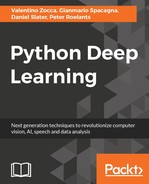In this chapter, we went through a long journey of optimizations, tweaks, testing strategies, and engineering practices to turn our neural network into an intrusion detection data product.
In particular, we defined a data product as a system that extracts value from raw data and returns actionable knowledge as output.
We saw a few optimizations for training a deep neural network to be faster, scalable, and more robust. We addressed the problem of early saturation via weights initialization. Scalability using both a parallel multi-threading version of SGD and a distributed implementation in Map/Reduce. We saw how the H2O framework can leverage Apache Spark as the backend for computation via Sparkling Water.
We remarked the importance of testing and the difference between model validation and full end-to-end evaluation. Model validation is used to reject or accept a given model, or to select the best performing one. Likely, model validation metrics can be used for hyper-parameter tuning. On the other hand, end-to-end evaluation is what quantifies more comprehensibly how the full solution is solving real business problems.
Ultimately, we did the last step—to deploy the tested model straight into production, by either exporting it as a POJO object or turning it into a service via a REST API.
We summarized a few lessons learnt in the experience of building robust machine learning systems and deeper architectures. We expect the reader to use those as a basis for further development and customized solutions according to each use case.
